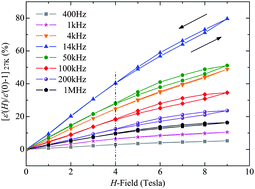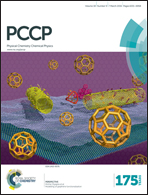Magneto-thermally activated spin-state transition in La0.95Ca0.05CoO3: magnetically-tunable dipolar glass and giant magneto-electricity
Abstract
The magneto-dielectric spectroscopy of La0.95Ca0.05CoO3 covering the crossover of spin states reveals the strong coupling of its spin and dipolar degrees of freedom. The signature of the spin-state transition at 30 K clearly manifests in the magnetization data at a 1 Tesla optimal field. Our Co L3,2-edge X-ray absorption spectrum on the doped specimen is consistent with its suppressed low-to-intermediate spin-state transition temperature at ∼30 K compared to ∼150 K, documented for pure LaCoO3. The dispersive activation step in the dielectric constant  with the associated relaxation peak in imaginary permittivity
with the associated relaxation peak in imaginary permittivity  characterize the allied influence of coexistent spin-states on the dielectric character. Dipolar relaxation in the low-spin regime below the transition temperature is partly segmental (Vogel–Fulcher–Tamman (VFT) kinetics) and features magnetic-field tunability, whereas in the low/intermediate-spin disordered state above ∼30 K, it is uncorrelated (Arrhenic kinetics) and almost impervious to the magnetic field H. Kinetics-switchover defines the dipolar-glass transition temperature Tg(H) (=27 K|0T), below which their magneto-thermally-activated cooperative relaxations freeze out by the VFT temperature T0(H) (=15 K|0T). An applied magnetic field facilitates thermal activation in toggling the low spins up into the intermediate states. Consequently, the downsized dipolar-glass segments in the low-spin state and the independent dipoles in the intermediate state exhibit accelerated dynamics. A critical 5 Tesla field collapses the entire relaxation kinetics into a single Arrhenic behaviour, signaling that the dipolar glass is completely devitrified under all higher fields. The magneto-electricity (ME) spanning sizeable thermo-spectral range registers diverse signatures here in kinetic, spectral, and field behaviors, in contrast to the static/perturbative ME observed close to the spin-ordering in typical multiferroics. Intrinsic magneto-dielectricity (50%) along with vanishing magneto-loss is obtained at (27 K/50 kHz)9T. The sub-linear deviant and field-hysteretic split seen in
characterize the allied influence of coexistent spin-states on the dielectric character. Dipolar relaxation in the low-spin regime below the transition temperature is partly segmental (Vogel–Fulcher–Tamman (VFT) kinetics) and features magnetic-field tunability, whereas in the low/intermediate-spin disordered state above ∼30 K, it is uncorrelated (Arrhenic kinetics) and almost impervious to the magnetic field H. Kinetics-switchover defines the dipolar-glass transition temperature Tg(H) (=27 K|0T), below which their magneto-thermally-activated cooperative relaxations freeze out by the VFT temperature T0(H) (=15 K|0T). An applied magnetic field facilitates thermal activation in toggling the low spins up into the intermediate states. Consequently, the downsized dipolar-glass segments in the low-spin state and the independent dipoles in the intermediate state exhibit accelerated dynamics. A critical 5 Tesla field collapses the entire relaxation kinetics into a single Arrhenic behaviour, signaling that the dipolar glass is completely devitrified under all higher fields. The magneto-electricity (ME) spanning sizeable thermo-spectral range registers diverse signatures here in kinetic, spectral, and field behaviors, in contrast to the static/perturbative ME observed close to the spin-ordering in typical multiferroics. Intrinsic magneto-dielectricity (50%) along with vanishing magneto-loss is obtained at (27 K/50 kHz)9T. The sub-linear deviant and field-hysteretic split seen in  above 4 Tesla suggests the emergence of robust dipoles organized into nano-clusters, induced by the internally-generated high magneto-electric field. An elaborate ω–T multi-dispersions diagram maps the rich variety of phase/response patterns, revealing highly-interacting magnetic and electric moments in the system.
above 4 Tesla suggests the emergence of robust dipoles organized into nano-clusters, induced by the internally-generated high magneto-electric field. An elaborate ω–T multi-dispersions diagram maps the rich variety of phase/response patterns, revealing highly-interacting magnetic and electric moments in the system.



 Please wait while we load your content...
Please wait while we load your content...